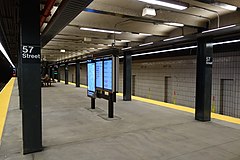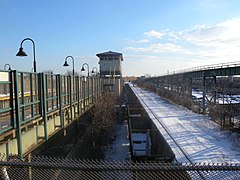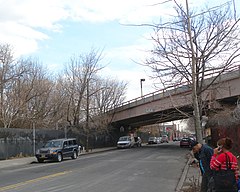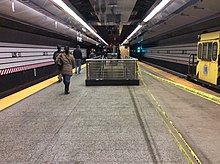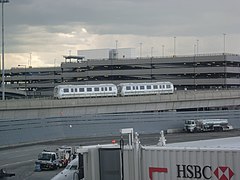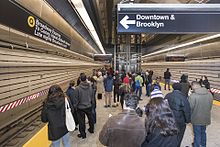Program for Action
Transport improvements built under the Program for Action were supposed to relieve overcrowding on existing transit modes in the New York City area.
However, even though many of the lines and transport connections proposed in the Program for Action were approved, New York City nearly went bankrupt in 1975, causing all but two of these projects to be canceled due to a lack of funds.
[3] In 1965, the Metropolitan Commuter Transportation Authority (MCTA) was created by the New York State Legislature to operate the bankrupt Long Island Rail Road.
[5] The MCTA's chairman at the time, William Ronan, said that any extensions of the New York City Subway that were funded using the bond issue would not be complete for at least another 5 years.
[9] On February 29, 1968, the MCTA published a 56-page report for New York Governor Nelson A. Rockefeller, and in it, proposed several subway and railroad improvements under the name "Metropolitan Transportation, a Program for Action"[3][10][8][11] (alternatively called the "Grand Design"[12]).
This included Lindsay's Linear City plan for housing and educational facilities, and the projected construction of several Interstate Highways, many of which were originally proposed by Robert Moses.
[18][2][30][27] Both lines were only built to Jamaica Center; a LIRR extension would have necessitated the construction of new stations or the conversion of existing facilities along the right-of-way, as well as added additional capacity on which to run trains.
[45][25] The SAS was prioritized due to overcrowding on the IRT Lexington Avenue Line, which was the only remaining rapid transit service on the east side in Midtown and Upper Manhattan.
[58] The MTA contended that its studies had shown that Third Avenue was the only feasible place to put the terminal, and there would have been too great of a concentration of rail lines at Grand Central.
[3][49] On September 20, 1968, the New York City Board of Estimate and Mayor John Lindsay approved six of the Transit Authority's eight recommended routes at the cost of $1.3 billion.
[81] While the Program for Action was ongoing, the MTA experienced growing fiscal deficits, which led to gradually increasing fare prices as well as a declining quality of service.
[26] Construction for the Second Avenue Line was halted indefinitely in 1975,[86][c] but when the United States government ceased to fund the two remaining projects ten years later, neither of them had been completed.
[85] The New York Times reported in May 1978 that the expansion had been reduced to 1⁄5 of its original length, saying, "The line costs $100,000 a foot, will be very short and will serve only a modest number of riders."
The article now noted that the Queens super-express had been deferred "to 1988 at the earliest," and the only sections in progress were the 63rd Street Line to Northern Boulevard, and "a small piece along Archer Avenue."
[19]: 244 By 1980, the MTA considered stopping the project and diverting the money to existing subway infrastructure, which was heavily vandalized, severely deteriorating, and devoid of riders.
[92] In 1981, due to lack of money, all bidding on new subway and bus projects for the MTA was suspended, except for the already-built portions of the 63rd Street and Archer Avenue lines.
[1] The MTA was studying four options for making this line more useful:[94][1] The suburban Glendale, Ridgewood and Middle Village communities in central Queens strongly opposed any proposals involving the Montauk Branch, which ran through their neighborhood.
[83]: 355 However, the 63rd Street Subway's eastern Queens extension was no longer being planned,[43][84] although a bellmouth was built at the end of the tunnel, past 21st Street–Queensbridge, as a provision for the express bypass.
[1] As part of the connector, a new bellmouth and additional tail tracks were built to facilitate a future line such as the bypass options or construction of a transfer station.
[91] However, New York City became insolvent during the 1975–1976 fiscal crisis, and in October 1980, officials considered stopping this project as well and diverting the money to mend existing infrastructure.
[69][c] Of this failure to complete construction, Gene Russianoff, an advocate for subway riders since 1981, stated: "It's the most famous thing that's never been built in New York City, so everyone is skeptical and rightly so.
[122] In October 1974, the president of the Hammel Holland Seaside Civic Association wrote to Mayor Abraham Beame, "It is our earnest plea to you that your decision on this rape of Forest Park be rescinded."
The association's president added that although it would be cost-ineffective to create a premium service to JFK Airport, the Rockaway Beach Branch should still be reactivated for local passengers.
[116] In 1978, after the Program for Action had been mostly scrapped, independent organizations pushed for the construction of a direct subway link from the IND Rockaway Line south of Aqueduct–North Conduit Avenue.
[124] A later study for a dedicated two-lane rapid transit bus line to JFK along the Rockaway Beach Branch, called the "Transitway", was released in 1982.
[129][128][130] In 1987, the Port Authority brought up a similar proposal to connect a new five-story, $500 million transportation center with all of the airport's terminals, in conjunction with the under-construction JFK Expressway.
[131]: 2 During the previous year, all three airports had experienced an unusually large increase in passenger counts and were now accommodating one-and-a-half to two times their design capacity.
This budget included a $1.6 billion LIRR connection to Grand Central Terminal, called East Side Access, as well as several subway extensions.
[156]: ES2 In 1990, the MTA proposed a $1.6 billion rail link to LaGuardia and JFK airports, which would be funded jointly by agencies in the federal, state, and city governments.
Mario Cuomo's successor, George Pataki, expressed skepticism about the JFK rail link's viability during the previous year's gubernatorial campaign.

